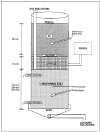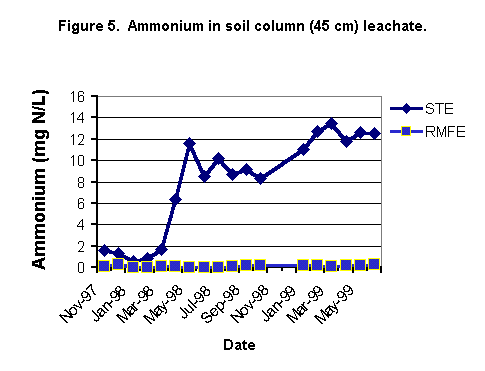
You've reached the Virginia Cooperative Extension Newsletter Archive. These files cover more than ten years of newsletters posted on our old website (through April/May 2009), and are provided for historical purposes only. As such, they may contain out-of-date references and broken links.
To see our latest newsletters and current information, visit our website at http://www.ext.vt.edu/news/.
Newsletter Archive index: http://sites.ext.vt.edu/newsletter-archive/

Impact of Recirculating Media Filter Effluent and Soil Depth Required for Renovation of Domestic Wastewater
Crop and Soil Environmental News, February 2000
R. B. Reneau, Jr., C. Hagedorn, M. Saluta, and V. Groover
Department of Crop and Soil Environmental Sciences, Virginia Tech
This is a brief summary of our soil column research being conducted at the Kentland Research Farm in Blacksburg, Virginia. The information presented in this document is data collected through June, 1999. After June, we changed the rate of wastewater application to both the recirculating media filter and the soil columns. We will report preliminary data for the higher wastewater application rates within the next two years.
Increased population density in suburban and rural areas heightens requirements for on-site wastewater treatment and disposal systems (OSWTDS). In these areas, soils are relied on to remove biological and chemical constituents from wastewaters before they reach surface or ground waters. To further emphasize the importance of effective wastewater treatment, the majority of homes that employ OSWTDS also drink well water. The close proximity of OSWTDS to drinking water makes OSWTDS performance vital to public health. However, the traditional OSWTDS may not function properly on soils that have limitations such as low hydraulic conductivity, high seasonal or permanent water table, or shallow depth to rock or other restricting layers. Some 65% of the nation's soils may have limitations that restrict the use of traditional OSWTDS. One possible way to overcome soil limitations is application of highly pretreated wastewater. We are examining the relationship between wastewater quality and application rate on soil depth required for renovation and on changes in soil infiltration rates.
 |
Wastewater used in this study comes from a single family home and receives primary treatment in a septic tank. The septic tank effluent (STE) undergoes further treatment in a recirculating media filter (RMF). The filter, shown in Figure 1, is similar to the one used in this research. However, in our research, the media is a boiler slag produced in coal-fired electrical generators of a "wet-bottom cyclone system" design. Also, effluent was applied to the media by sprinklers to achieve more uniform distribution. Design features and operating conditions for the RMF are given in Table 1. |
| Figure 1. Schematic of a recirculating media filter (Schulz and Otis, 1999) | |
|
Table 1. Design Characteristics for the Recirculating Media Filter. |
|
|
STE loading rate |
291 L (77 gallons) per day |
|
Recirculate loading rate |
7816 L (2065 gallons) per day |
|
Filter dose volume |
163 L (43 gallons) per dose |
|
Number of doses per day |
48 |
|
Recirculation ratio |
27:1 |
|
Dilution ratio in recirculation tank |
4:1 |
|
Filter on/off times |
3 min/27min |
|
Filter hydraulic loading |
13.6 cm per dose |
|
Filter media depth |
0.6 m |
|
Filter media dimensions |
2.29 m length x 1.07 m width |
|
Media effective size (D10) |
2.30 mm |
|
Media uniformity coefficient(D60 /D10) |
1.53 |

|
Thirty, undisturbed soil columns (Fig. 2) were placed in a column house located at the Virginia Tech Kentland Research Farm. Soil columns were collected by pushing 20-cm diameter PVC pipes into a Braddock soil (fine loamy, mixed, mesic Typic Hapludult) with a Giddings hydraulic soil probe and then removing them with a backhoe. Ten treatments [0, 15, 30, and 45 cm of soil dosed at 2.13 and 4.26 cm d-1 with RMF effluent (RMFE); 30 cm of soil dosed at 6.39 cm d-1 with RMFE; and 45 cm of soil dosed at 2.13 cm d-1 with STE] replicated three times were used in this study. Effluent was introduced twice daily into the gravel layer. The 45 cm soil column dosed with 2.13 cm d-1 STE was used for comparison. Duncan (1994 ) reported that this soil depth and application rate was adequate for STE renovation.
|
| Figure 2. Schem atic of soil columns. | |
Leachate was collected monthly and analyzed for chemical and biological parameters. Ammonia (NH4), nitrate (NO3), and ortho-phosphate (PO4) were analyzed with an autoanalyzer; pH with a combination electrode assembly; five-day biological oxygen demand (BOD5) and dissolved oxygen (DO) with a DO meter; fecal coliform (FC) using the membrane filter technique; and total suspended solids (TSS) by weight.
The RMF was effective in treatment of STE (Table 2 ). Both TSS and BOD5 where reduced to <5 mg L-1 while the DO in RMFE averaged 88% of saturation (Fig. 3). The FC count was reduced from 69,000 to 520 (Table 2) while the log normalized counts were reduced from 26,500 to 22 CFU 100mL-1. Most of the inorganic N in the RMFE was present as NO3- indicating that the RMF remained highly aerobic during the study. Nitrogen loss in the RMF averaged 15% over the past two years. There was no difference in P concentration between STE and RMFE indicating the media had limited capacity for P removal.
|
Table 2. Water Quality Parameters1for STE and RMFE. |
|||||||
|
FC |
BOD5 |
TSS |
NH4-N |
NO3-N |
PO4-P |
pH |
|
|
CFU 100mL-1 |
----------------------------mgL-1------------------------------- |
||||||
|
STE |
69,000a* |
99.1a |
44a |
40.8a |
0.3b |
8.98a |
7.1a |
|
RMFE |
520b |
3.9b |
2.7b |
0.4b |
39.6a |
8.06a |
7.3a |
SOIL COLUMNS
The NH4+ concentration in the leachate from 45 cm soil columns was influenced by effluent type (Figure 5). The NH4+ concentration was higher in leachate where STE was applied and first exceeded 8 mg N L-1 in 04/98 and remained at or above this level for the remainder of the study. In contrast, the leachate NH4+ concentration where RMFE was applied remained <1 mg N L-1 throughout the study.
The leachate NO3- concentration was influenced by effluent type and application rate (Figure 6). The leachate NO3- concentration was lower in columns dosed with STE than columns dosed with RMFE. The lower leachate NO3- concentration in columns dosed with STE may be a result of enhance denitrification or NH4 adsorption or both. Where RMFE was applied, leachate NO3- concentrations tended to increase with increased application rate. This apparently reflects a limited energy source in the soil column to facilitate denitrification. In field installations greater denitrification losses would be expected because of the larger volume of soil available. Also, installations close to the soil surface would have a renewable C source from root exudates.
 |
 |
| Infiltration
Rates
Infiltration rates tended to increase with increased RMFE application rate and soil depth. The infiltration rates for the 15 cm columns dosed at 2.13 cm d-1 with RMFE were much lower than rates measured for the other columns with the exception of columns dosed with STE. This lower infiltration rate is attributed to the collection of these columns at an adjacent location where the soil had a lower hydraulic conductivity. The columns dosed with STE have much lower infiltration rates than the 45 cm columns dosed with RMFE. Infiltration rates in 1999 were lower than rates measured in 1998. Infiltration rates will be monitored over time to determine if an equilibrium is established of if rates will continue to decrease.
|
 |
1. The recirculation media filter produced a highly treated wastewater with minimal maintenance.
2. Highly pretreated wastewater can be applied to shallow soils at a higher than recommend rate (VDH, 1982) with little increased potential for degradation of surface and ground waters.
3. Soil infiltration rates are higher where highly pretreated wastewater is applied to the soil as compared to STE application.
1. Duncan, Carla S. 1994. Wastewater renovation with soil depth as influenced by additional treatment of septic tank effluent. M.S. Thesis, Virginia Polytechnic Institute and State University. 110 pp.
2. Virginia Department of Health. 1982. Sewage Handling and Disposal Regulations. Virginia Dept. Of Health. Richmond, Va.
Visit Virginia Cooperative Extension